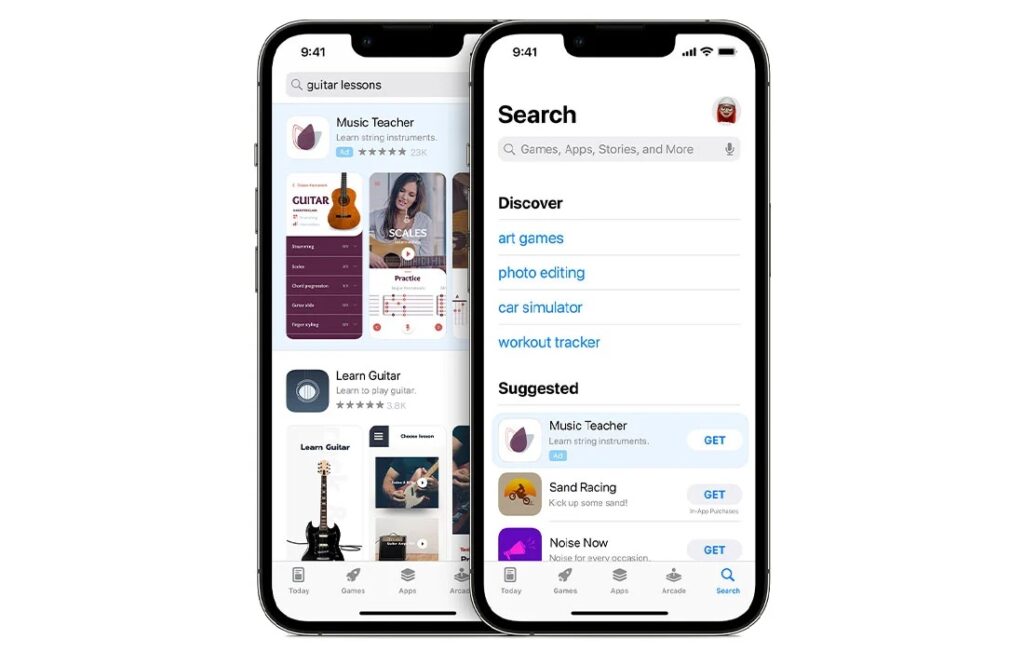Apple will test two new App Store Ad placements on the App Store. Today, we will show you the signals it sends to users, advertisers, or all mobile app marketers. What do these new ad placements mean for users and advertisers?
Introducing App Store Ad Placement
Android can be frustrating for users due to the abundance of ads. These ads can easily be triggered by accidental screen taps or interactions with the search bar, leading to automatic downloads of various software. In contrast, Apple’s system has consistently received praise for its clean, smooth, ad-free experience. Currently, the Apple App Store offers two ad spaces: one within the search tab and another in search results.

However, there are reports that Apple will soon test two more ad slots on the App Store. These new placements include ad space on the Today page of the App Store and ad space in the “You May Also Like” section of the app’s product page. To distinguish them from organic referrals, these ads will be clearly marked as ads.

In the realm of mobile device manufacturers, why are they so eager to integrate ad space into their devices? The answer is straightforward: profit. Android manufacturers have consistently been reluctant to abandon ads because they yield substantial revenue. On the other hand, Apple has taken a different approach. While it only offers ad services within its built-in app store, it still generates significant profits. Analysts predict that by 2025, Apple’s advertising and promotional business, especially search ads, will bring in at least $6 billion in profit.
Apple’s Commitment to Transparency and Privacy
Apple states that its new ad placements align with its emphasis on transparency and privacy. The company avoids excessive targeting of specific users or niche audiences and refrains from displaying personalized ads to individuals under 18. Furthermore, Apple never uses sensitive data such as political or religious information for ad targeting. These policies ensure that Apple Search Ads practitioners can identify potential customers while maintaining user privacy and trust.
Impact on mobile app advertisers
Despite Apple tightening its privacy policies, the launch of new ad display spaces has brought mobile app advertisers fresh opportunities. How can they seize these chances and precisely target their customer?
Apple’s Search Ads
- Search Match:
- Apple Search Ads Advanced offers an interesting feature called “Search Match.” This tool allows advertisers to automatically target ads based on search queries, enabling quick campaign launches.
- Search Match analyzes relevant ads and provides suggestions, saving advertisers time and effort in creating keyword lists. It leverages metadata from app store pages and other apps within the same category to generate these recommendations.
- Keyword Targeting:
- While Search Match simplifies ad targeting, keywords remain crucial for an effective App Store advertising strategy.
- Apple Search Ads allows advertisers to bid on keywords and provides additional tools for keyword targeting.
- The default setting is “Broad Match,” which expands targeting by delivering ads for keyword variants. For precise targeting, advertisers can choose the “Exact Match” option and use negative keyword matching to include or exclude specific keywords and variants.
- Audience Targeting:
- Another essential feature of Apple Search Ads positioning is the ability to cover specific audience segments based on their previous interactions with the app.
- Advertisers can target all App Store users, new users, returning users, or users who have previously used other apps from the same developer.
- By tailoring ads to these different customer types, advertisers can improve their return on ad investment.
Remember that transparency and privacy are critical in advertising practices, especially as Apple continues to refine its privacy policies.

- Population Targeting Accurate targeting is crucial for successful advertising, and Apple Search Ads provides audience segmentation options based on age and gender. Understanding your target audience and using demographic targeting can significantly enhance ad effectiveness. However, it’s important to note that ads won’t be shown to users under the age of 13, and there are additional age restrictions in different regions.
- Device Targeting Another essential feature of Apple Search Ads is audience targeting based on device type. Advertisers can flexibly adjust bids according to device types or customize audience criteria specific to certain devices. For example, if an app performs better on iPhones despite being available on all platforms, advertisers can modify their bids accordingly.
- Location Targeting Location plays a crucial role in many applications, and Apple Search Ads allows precise targeting for specific regions. Advertisers can deliver location-based ads to users in particular areas or near businesses. Understanding your audience, product, and using accurate targeting practices are essential for maximizing the effectiveness of Apple Search Ads.
In conclusion
With the launch of new ad placements, Apple is aligning itself with other app stores by providing more advertising opportunities. By implementing the positioning strategies mentioned above, advertisers can efficiently target and reach their desired audience on the Apple platform.
